Recent Articles
Popular Makes
Body Types
2020 Toyota 4Runner Road Test and Review
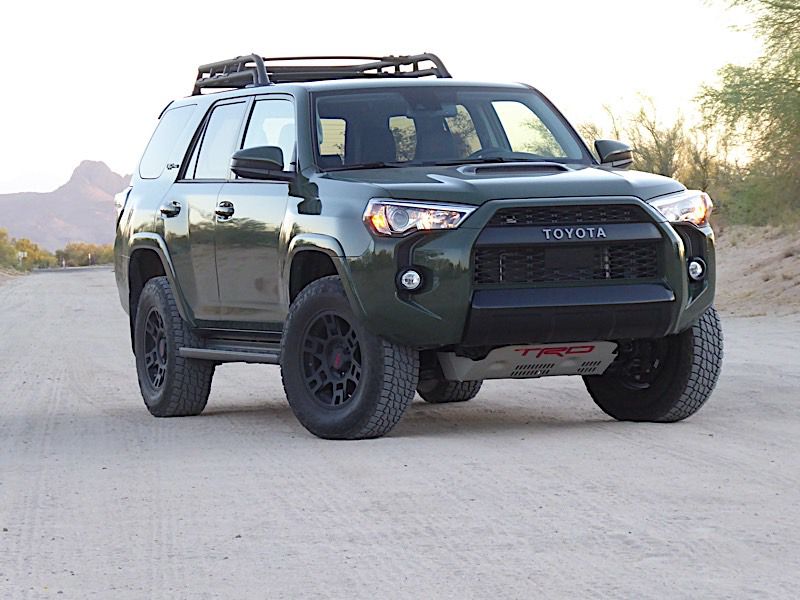
204runnerfrontbeauty3sessions ・ Photo by Ron Sessions
The Toyota 4Runner first broke cover as a pickup truck-based sport-utility in 1984, and by the mid-1990s, it was in the thick of a fast-expanding segment of mid-size SUVs such as the Ford Explorer, Nissan Pathfinder, Jeep Cherokee, and Chevrolet S-10 Blazer. In the ensuing decades, sport-utilities became the dominant market segment — but one inhabited mostly by car-based “soft-roaders” such as Toyota’s own RAV4 and Highlander, and the present-day successors to all those 1990s SUV stalwarts.
With the passing of the FJ Cruiser and prices of the Land Cruiser approaching triple digits, the 4Runner has emerged as Toyota’s only affordable, truck-tough SUV. For 2020, the 4Runner adds standard safety features, gets much-needed updates to its infotainment system, and expands its model lineup, adding a new Venture trim merging TRD Off-Road content with a huge Yakima Megawarrior roof rack. Toyota also continues its recently rolled-out Nightshade Edition 4Runner with blackout trim inside and out. Including the $1,120 destination charge, the extensive 2020 Toyota 4Runner lineup starts with the $37,240 SR5 and includes the $40,435 SR5 Premium, $40,960 TRD Off-Road, $43,690 TRD Off-Road Premium, $45,505 Venture Edition, $46,105 Limited, $47,845 Nightshade Edition, and $50,985 TRD Pro.
Old-School Interior
You’re riding tall in the 4Runner, courtesy of its pickup truck-like body-on-frame construction. The high step-in height takes some getting used to, especially for vertically challenged passengers, but optional running boards ease the hike up there. Low seat bottom cushions help salvage a modicum of front-seat headroom, but the longitudinal orientation of the drivetrain means the transmission and driveshaft tunnel steal space between the seats down the center of the vehicle. Combined with the 4Runner’s narrow width, there isn’t the spread-out room that you’d find, say, in a Toyota Highlander.
A power driver’s seat with power-adjustable lumbar is standard in all 4Runner trims, with SR5 Premium and higher trims adding a power-operated front passenger seat. The front seats are heated in SR5 Premium and higher trims, and cooled as well in the Limited and Nightshade models. Seat coverings are cloth in the base SR5, upgrading to faux leather in SR5 Premium, Adventure, and all TRD trims, and going all the way to perforated leather in the Limited. Air conditioning with an interior air filter and rear-seat vents is standard, with TRD Pro and Limited trims adding dual-zone automatic climate control.
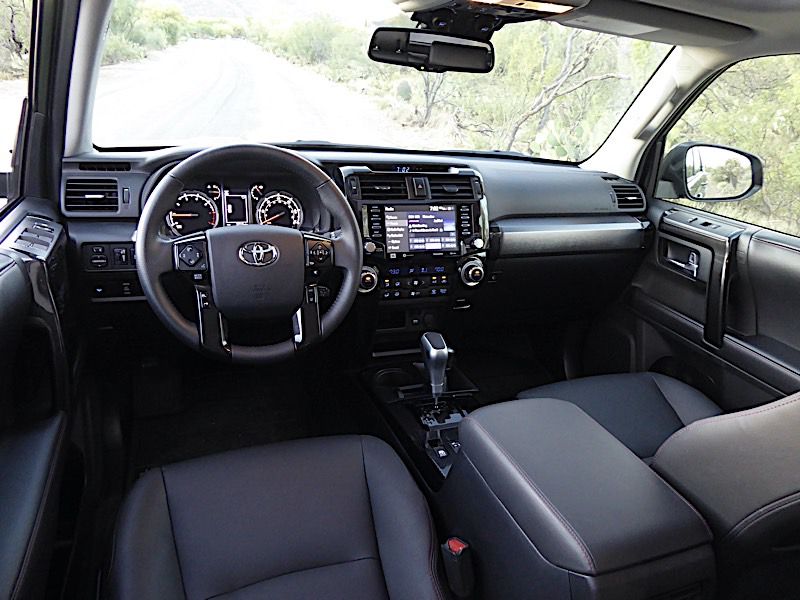
Photo by Ron Sessions
Updated Infotainment
As with the 2020 Tacoma pickup, all 4Runner models get upgraded from a 7-inch to a standard 8-inch infotainment screen this year. Also standard for the first time in the 4Runner are Apple CarPlay and Android Auto cellphone mirroring as well as Amazon Alexa compatibility. This enables users to bring their cellphone’s top screen layout and major apps into the 4Runner’s display.
The 8-inch display is a touchscreen with decent-sized tiles for accessing content, but Toyota wisely kept meaty analog knobs for volume and tuning that are easy to find and adjust in a hurry, even on bumpy back roads or when wearing gloves. Also handy are hard shortcut buttons for most major multimedia functions flanking the screen, plus steering-wheel audio controls and voice commands. An in-vehicle 4G LTE Wi-Fi Connect system is also on board for a three-month 2-GB trial in all models. The standard audio system for the 4Runner SR5, SR5 Premium, and TRD Off-Road models is a six-speaker AM/FM stereo with SiriusXM and Bluetooth streaming capability. The Limited, Nightshade Special Edition, and TRD Pro upgrade to a JBL system with 15 speakers that also includes HD radio, Clari-Fi music restoration software, and embedded Dynamic Navigation.
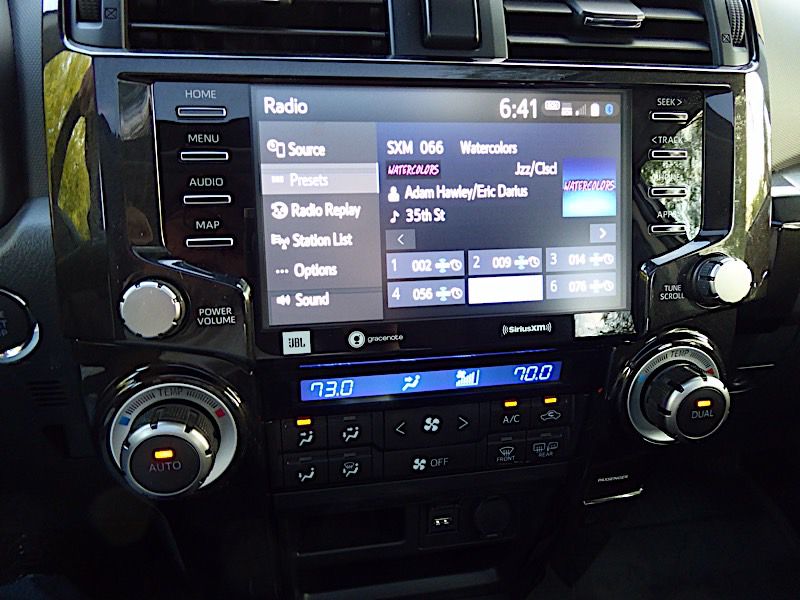
Photo by Ron Sessions
Second-Row Squeeze
The 4Runner’s second-row seat is a bench with folding 40/20/40 split seatbacks and a fold-down center armrest with cup holders. The seatbacks can be reclined up to 16 degrees, great for stargazing through the power tilt/slide moonroof standard in the Limited and the TRD Pro.
The second row is a bit tight for tall adults, offering almost an inch less headroom than in the compact Toyota RAV4 or mid-size Highlander and nearly 5 inches less legroom than the RAV4 and almost 10 inches less back there than in the Highlander. All 4Runner models feature standard LATCH lower child-seat anchors on second-row outboard seat locations. Also available on the SR5 and Limited models is a seven-passenger version with a very compact third-row seat. It folds flat and is split 50/50. The rearmost seat on these versions is suitable only for carrying children. Access to the third row is aided by a one-touch sliding feature on the second-row seats. Standard dark-tint glass for the rear doors, rear quarters, and liftgate adds privacy and cuts down on solar load.
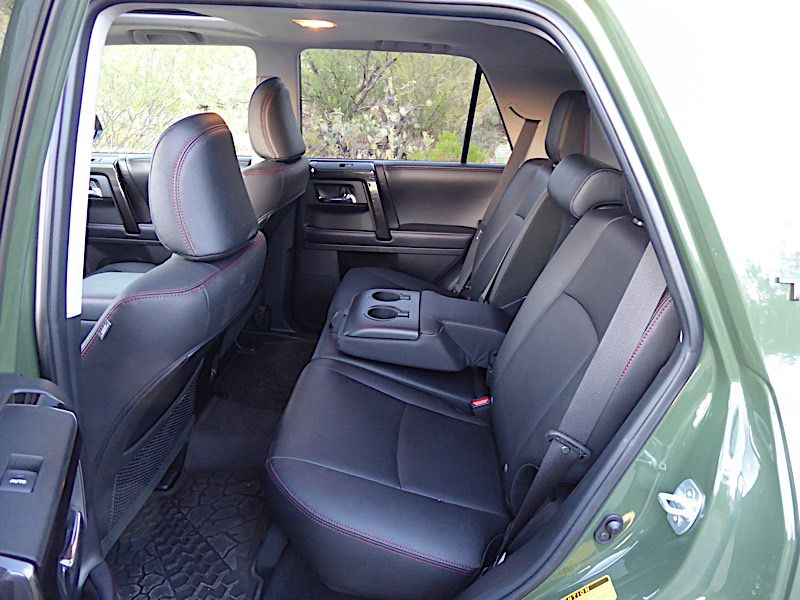
Photo by Ron Sessions
Max Cargo
The five-passenger 4Runner’s rear seatbacks fold flat, but first you must pivot the bottom cushions forward against the rear of the front seatbacks. With the rear seat cushions this way, there’s less room inside the cargo bay for loading longer items flat on the cargo floor such as ladders and lumber. In the five-passenger version, there’s a healthy 47.2 cubic feet of cargo space behind the rear seat and 89.7 cubic feet with the rear seat folded down. In the seven-passenger 4Runner, the third-row seatback is close to the rear liftgate, allowing just 9 cubic feet of cargo space when all seats are up.
The 4Runner has a couple of unique features not found in many other SUVs. One is a slide-out cargo floor or deck that forms a tailgate-like shelf when pulled all the way out. The slide-out deck is solidly constructed and can hold up to 440 lbs, making it a natural for tailgate parties. The other unusual feature is retractable liftgate glass. The glass is power operated and great for airing out the cargo bay. Standard fare in all 4Runners includes 120-volt and 12-volt power outlets in the cargo area for powering various camping or tailgating accessories.
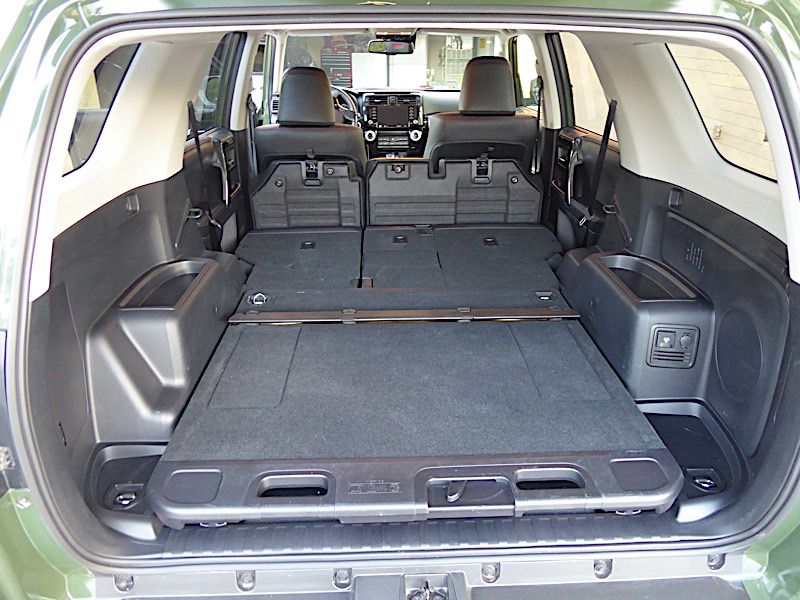
Photo by Ron Sessions
V6 Power
Toyota’s evergreen 4.0-liter V6 powers the 4Runner, where it makes a healthy 270 horsepower and 278 lb-ft of torque. It’s teamed with a well-proven wide-ratio five-speed automatic transmission, a few cogs short of the gearboxes Toyota is installing in its newer SUVs such as the RAV4 and Highlander. In the TRD Pro model, a low-restriction cat-back exhaust gives the SUV some entertaining snarl at wider throttle openings.
All 4Runner models are rated to tow 5,000 lbs and come standard with an integrated, weight-carrying tow-hitch receiver. EPA fuel mileage estimates are 17 mpg city/21 mpg highway/18 mpg combined with rear-wheel drive and 17 mpg city/20 mpg highway/18 mpg combined for four-wheel-drive models. I saw an observed 18.4 mpg in the TRD Pro’s average fuel economy readout over a week that involved as much off-pavement driving as I could find.
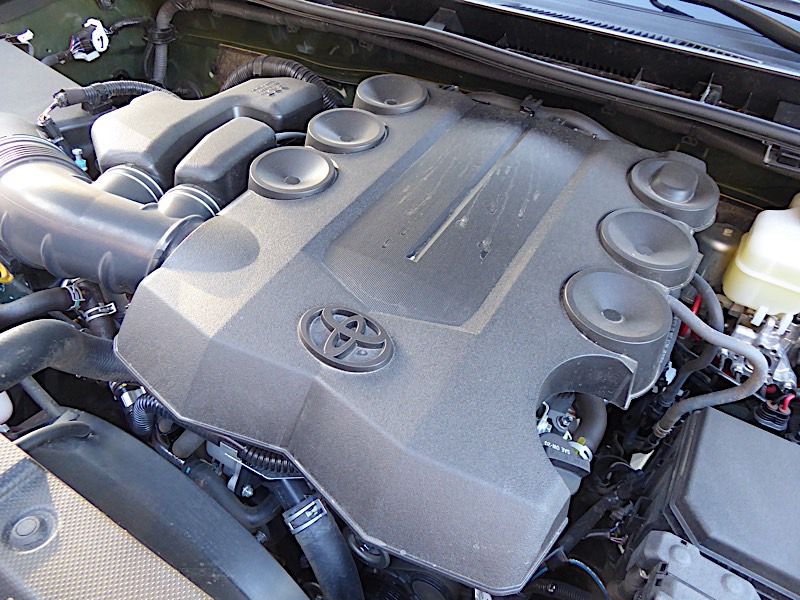
Photo by Ron Sessions
Off-Road Tech
All 4Runner models have a sturdy body-on-ladder-frame construction, beefy truck-based components, and skid plates that protect the engine, front suspension, and fuel tank from rocks and other off-road obstacles. 4WD models add a skid plate for the 4WD transfer case. 4Runners with part-time 4WD feature a 2.56:1 low-range reduction for slow-going over challenging terrain, activated with a traditional-style transfer-case lever on the center console. The Limited and Nightshade trims upgrade to multi-mode 4WD using a two-speed transfer case and a lockable Torsen limited-slip center differential.
TRD models add an electronic locking rear differential and a pair of driver-selectable systems operated from the overhead console. Crawl Control is off-road cruise control accessible with the SUV in low range. There are five speed settings available via the overhead dial, and when activated, the system allows the driver to concentrate on steering the best off-road path without worrying about engine speed and braking. With the TRD’s standard Multi-Terrain Select, the driver sets a second overhead dial according to anticipated off-road conditions. Selectable modes include mud, sand, and uneven terrain such as ridges, slopes, and ditches, tailoring wheel slip control to suit each situation.
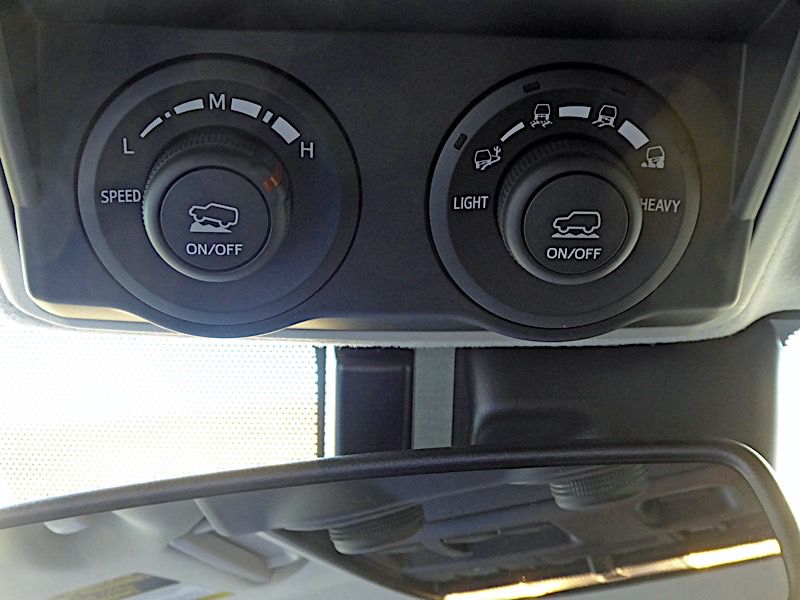
Photo by Ron Sessions
Suspension Upgrades
All 4Runner models feature a robust double A-arm front and multilink rear coil spring suspension. But the TRD Pro ups the ante with off-road racing-inspired 2.5-inch FOX dampers. The internal-bypass coil-over front and remote reservoir high-pressure gas long-travel shocks can handle rough terrain over long distances without losing their damping force. Beefy 265/70R17 Nitto Terra Grappler all-terrain tires work with TRD-tuned front springs and a 1-inch front suspension lift to give the 4Runner TRD Pro purchase over humps, ditches, rocks, and other off-pavement obstacles. The beauty of the beefed-up suspension is the excellent around-town ride quality it delivers with little of the jounciness associated with lifted trucks. As a side benefit, the TRD Pro suspension takes the edge off parking-lot speed bumps.
Limited models have their own unique X-REAS suspension system that automatically adjusts shock damping when cornering or encountering uneven surfaces. The system cross-links the dampers on opposite sides of the 4Runner, reducing head toss and annoying side-to-side pitch. Additionally, a Kinetic Dynamic Suspension System, optional on TRD Off-Road models, allows greater off-road control by reducing body lean when cornering and allowing extended wheel travel at low speeds.
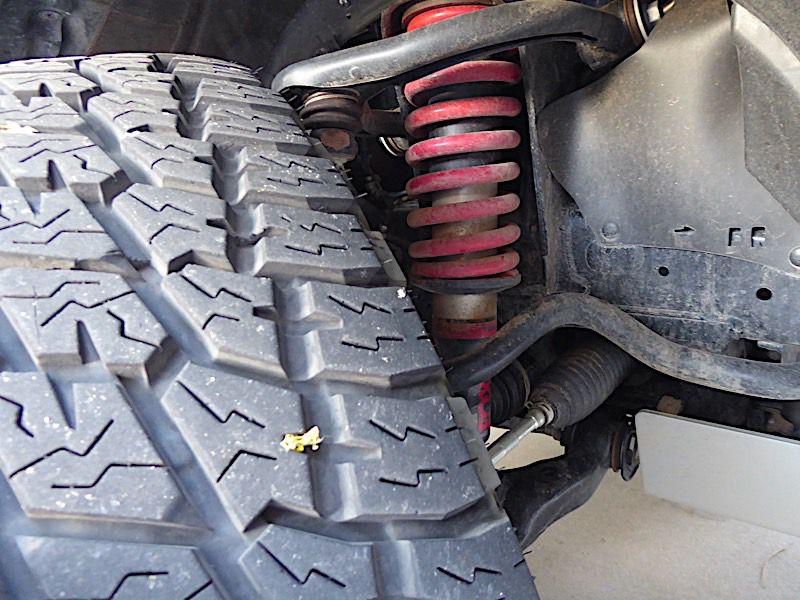
Photo by Ron Sessions
Driving Dynamics
The 4Runner sits tall, offering 9 inches of ground clearance on 2WD models and 9.6 inches with four-wheel drive. Compared to the scores of car-based crossovers and SUVs in today’s market, the 4Runner’s body/frame jiggle, firm ride, slow steering ratio, and somewhat mushy top-of-pedal brake feel give the sense that you’re driving a truck from several decades ago. And in many ways, you are.
What the 4Runner may lack in carlike sophistication it overachieves in sheer toughness. The Toyota 4Runner is an anvil, the truck you’d trust to handle whatever roads or trails it may encounter and get you back home in one piece. That’s the 4Runner’s appeal.
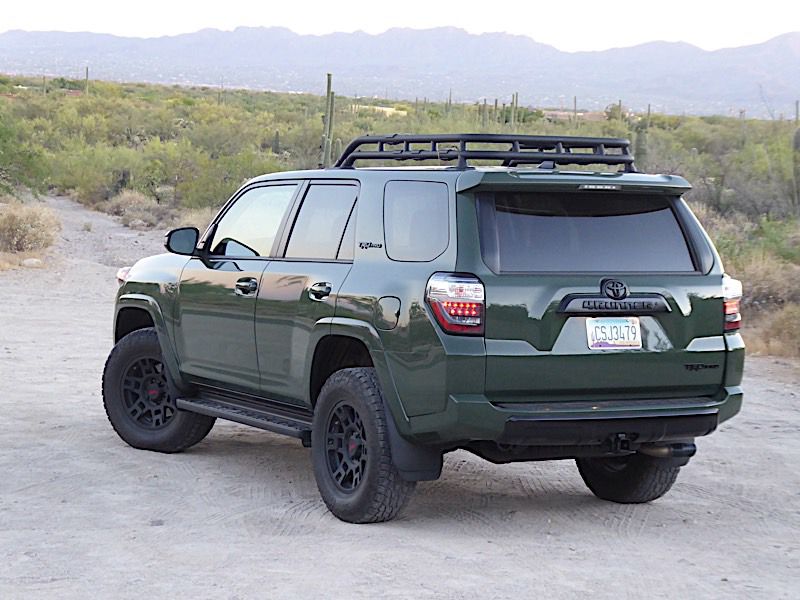
Photo by Ron Sessions
Safety Systems
Following an industry-wide trend, Toyota has expanded the 4Runner’s roster of standard safety systems for 2020. Toyota Safety Sense Plus content is now standard in all 4Runner models and now includes a pre-collision system with emergency automatic braking, automatic high beams, adaptive cruise control, and a lane-departure alert system.
All 4Runners also get eight airbags and a backup camera. Front and rear sonar-based parking assist that beeps more urgently the closer a bumper gets to an obstacle is included with the Limited trim. Blind-spot and rear cross-traffic monitoring are not available in the 4Runner.
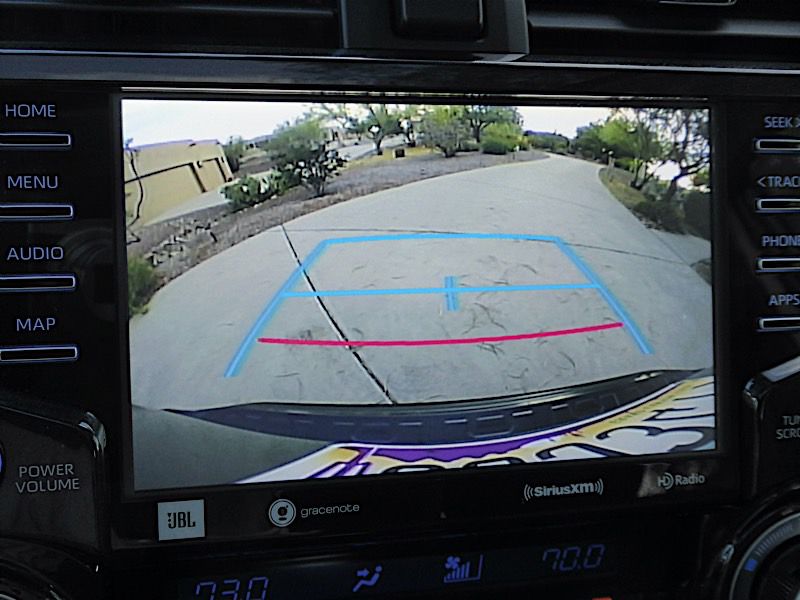
Photo by Ron Sessions
True Grit
Shown here in TRD Pro trim and Army Green paint, the 2020 Toyota 4Runner is a survivor of the truck-tough days of mid-size SUVs. Compared to more modern car-based designs such as Toyota’s own RAV4 and Highlander, the 4Runner is less space-efficient, gets worse gas mileage, and offers rougher-edged driving dynamics.
But for SUV buyers looking for a mid-size sport-utility with the grit to tackle dirt roads and rock-strewn trails, and do so for hundreds of thousands of miles without major repairs, the 4Runner is in a class of one.

Photo by Ron Sessions